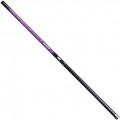Max. casting
The maximum weight of the entire rig (including bait, weights, hooks, etc.) that the rod can handle. This parameter is not recommended to be exceeded: the structure will be subjected to off-design loads and wear out a lot, to the point that the rod can simply break during a normal cast. In addition, the off-design weight of the casting significantly reduces the range and accuracy of the cast, which is critical, in particular, in spinning and match fishing (see "Rod type").
Min. casting
The minimum weight of equipment (lures, sinkers, hooks, floats, etc.) with which the rod will work effectively. Compliance with this parameter is important, first of all, for types of fishing that require high accuracy, for example, match or spinning (for more details, see "Rod Type") — a rig that is too light will not allow you to cast the rod far enough and accurately.
Rings
The presence
of rings in the design of the rod. Through them, the fishing line from the reel located in the handle area is passed to the tip, without tangling and without sticking to the rod itself. The presence of rings, by definition, is mandatory for any rod designed for use with a reel — without them it is impossible to bring the line to the desired point. The only type of rods that
do not have rings are
fly rods (see "Rod Type").
Folded length
The length of the rod when folded. This parameter primarily affects the convenience of transportation: the shorter the folded rod, the easier it is to carry / transport.
